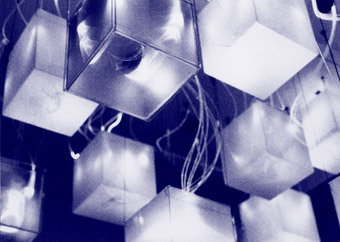Looking at light
Naomi Black, Madeleine Challender, Light Forms

Madeleine Challender, detail of Light Forms 2001, mixed media
‘pling
Madeleine Challender, detail of Light Forms 2001, mixed media
Perspex, red fluid, abstract shapes floating in space, spinning in time, light silently cast on the wall, refractions intersecting. The eye perceives a cloud of dust, the head of a snake, in strange deep space, eternally shifting, chasing its own tail. Red contours, like flames, the first stirrings of the universe. Silence. The gentle plucking of Japanese koto begins.
Madeleine Challender is a universal light worker. Light Forms, her latest exhibition of 2 thematically-charged installations and photographs appeared recently at the Canberra Contemporary Art Space. While CCAS’s Furneaux Street Gallery in Manuka regularly hosts up-and-coming artists like Challender, it was Galerie Gauche in Paris that housed her first exhibition with light, Thought Strings.
Paris, she explains, was the turning point for her art, where the decision was made to explore the medium of light. While on exchange at L’ecole Superieur des Beaux Arts from the Canberra School of Art, Challender worked under the tutelage of French installation artist Annette Messager. While in Paris, Challender exhibited her last paintings in Vancouver and turned to her new direction with passion.
Light is all around us. The parallels Challender draws as she observes light have led her to pose questions about nature, the universe and the mind, while exploring theories of interconnectedness through the processes of systems. The first of the 2 installations in the exhibition, Heart Gravity, was designed to be a dynamic system. “I was trying to make rather than represent a system. To take these fundamental elements and incorporate them to create an active working system,” she says.
Like the transition from the fundamental building blocks of Heart Gravity to the more complicated title piece of the show, Light Forms, systems can start simply and grow. Light Forms takes up half the small gallery space standing about 6 feet high and 6 feet wide.
System Element 1: The Space
Five curved perspex pieces are suspended from the ceiling. The plastic was about the size of A3 paper until the heat gun was taken to it. Each was moulded over an anatomically shaped heart. These are the fragments of space in Heart Gravity.
System Element 2: The Form
The red ink inside the perspex forms uniquely shaped pools, variations on one consistent liquid form. Red is a dominant colour in Challender’s work. It represents the heart that inhabits the space.
System Element 3: Movement and Time
The perspex shapes spin on mirror ball motors. Movement involves time. In Light Forms this movement is contained in boxes made of opaque perspex, textured glass and paper.
System Element 4: The Light
The light activates the red liquid and perspex shapes, and creates refracted images on the walls. In Light Forms, fibre optics are used to reconstruct the bending of light through the universe, and produce the effect of starlight flares through the hazed surfaces of the cubes into which they lead.
System Element 5: Dimension
At this point Heart Gravity’s simplicity, in which the perspex pieces are merely arranged at different heights, diverges from the 3-dimensional complexity of Light Forms.
Light Forms is a structure of sixteen 30cm cubes. A single box sits at the lowest height from which a clump of fibre optics springs and leads up to the ceiling. Two boxes at the second-lowest point sprout 2 clumps of fibre optics. And so it goes…doubling up to 8 clumps protruding from the top-most boxes. The idea of exponential growth.
A large mirror is placed under the work creating an illusion of depth, as though there is yet another dimension beneath the floor. The most active movement and refractions are only revealed by looking into the mirror.
System Element 6: Perception
People’s perceptions of the work are necessary to make the system complete. “It’s activating thought for people, stimulating them to form ideas and images in their minds,” says Challender. She believes that art must be accessible and open enough to allow interpretation: “I think that is a key element to life—everyone has their own individual experience.”
Madeleine CHallender hopes to remount Light Forms in Sydney later this year.
Light Forms was made possible through a grant from Arts ACT; Canberra Contemporary Art Space, February 16-25
RealTime issue #42 April-May 2001 pg. 36






